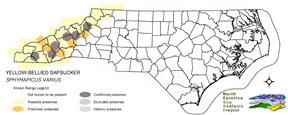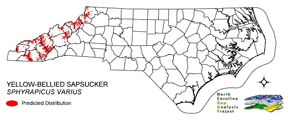
| Taxa: |
| Order: |
| Family: |
| Aves |
| Piciformes |
| Picidae |
| NatureServe Global Rank: |
| NatureServe State (NC) Rank: |
| G5 |
| S2B,S5N |
| Federal Status: |
| NC State Status: |
| --- |
| SR |


| Land Unit |
| US Fish & Wildlife Service |
| US Forest Service |
| US National Park Service |
| US Department of Defense |
| NC State Parks |
| NC University System |
| NC Wildlife Res. Com. |
| NC Forest Service |
| NC Div. of Coastal Mgmt. |
| Local Governments |
| Non-Governmental Org. |
| Other Public Lands |
| Private Lands |
| GAP Status 1-2 |
| All Protected Lands |
| Statewide |
| Hectares |
| 0.00 |
| 120,987.99 |
| 0.00 |
| 52,166.52 |
| 246.96 |
| 61.29 |
| 1,733.94 |
| 2.04 |
| 0.00 |
| 4,234.59 |
| 4,072.14 |
| 0.00 |
| 162,487.17 |
| 73,727.70 |
| 183,424.47 |
| 345,992.64 |
| Acres |
| 0.00 |
| 298,967.78 |
| 0.00 |
| 128,906.25 |
| 610.25 |
| 151.45 |
| 4,284.66 |
| 15.12 |
| 0.00 |
| 10,463.90 |
| 10,062.48 |
| 0.00 |
| 401,514.46 |
| 182,195.16 |
| 453,261.73 |
| 854,976.35 |
| % of Dist. on |
| Prot. Lands |
| 0.0 % |
| 66.0 % |
| 0.0 % |
| 28.4 % |
| 0.1 % |
| < 0.1 % |
| 0.9 % |
| < 0.1 % |
| 0.0 % |
| 2.2 % |
| 2.2 % |
| 0.0 % |
| 0.0 % |
| 40.2 % |
| ----- |
| ----- |
| % of Dist. on |
| All Lands |
| 0.0 % |
| 35.0 % |
| 0.0 % |
| 15.1 % |
| < 0.1 % |
| < 0.1 % |
| 0.5 % |
| < 0.1 % |
| 0.0 % |
| 1.2 % |
| 1.2 % |
| 0.0 % |
| 47.0 % |
| 21.3 % |
| ----- |
| ----- |
|
Separate breeding race is found rarely to uncommonly in the high elevations of the mountains (Alsop 1991, Simpson 1991), representing the southeasternmost range of the species (Nicholson 1997). Locally, breeds only in open oak and northern hardwood forests (Simpson 1992). Excavates cavities from 8 to 40 feet above the ground on a smooth section of the tree (Nicholson 1997). Feeds on the inner bark of trees, then returns later to eat the insects attracted to the bleeding sap (Alsop 1991). NATURE SERVE GLOBAL HABITAT COMMENTS: Deciduous or mixed deciduous-coniferous forest; in migration and winter also in a variety of forest and open woodland habitats, parks, orchards (AOU 1983). Nest hole is bored by both sexes; usually located 3-14 m above ground. Generally excavates a new hole each year. See Mitchell (1988) for specifications for the construction and placement of nest boxes. |
| Code | Name | Description | NC Natural Heritage Program Equivalent |
| 517 | Hemlock Floodplain Forest | Alluvial forest with hemlock and/or white pine in mountains and western piedmont. Hydrology is generally temporarily to seasonally flooded. | Canada Hemlock Forest |
| 522 | Northern Hardwoods | High Elevation forests including yellow birch, American beech, and yellow buckeye. Includes forests with Hemlock and Yellow Birch. | Northern Hardwoods Forest, Boulderfield Forest |
| 525 | Appalachian Oak Forest | A variety of oak forest types including Black, White, Scarlet Oaks in dry to mesic situations. Includes forests historically co-dominated by American Chestnut. | High Elevation Red Oak Forest, Montane White Oak Forest |
| 526 | Appalachian Cove Forest | Mixed Mesophytic forests of the mountains. Includes tuliptree, basswood, yellow buckeye and surgar maple. This class is mapped to include cove forests dominated or co-dominated by hemlock. | Rich Cove Forest, Acidic Cove Forest |
| 527 | Appalachian Hemlock | Upland hemlock forests of the moutains region. Vary from side slopes to steep slope positions. | Canada Hemlock Forest |
| 529 | Appalachian Xeric Mixed Forest | Mixed forests with Virginia, Shortleaf, Eastern White Pine, Table Mountain and Pitch pines in combination with xeric oak species. Oaks include, white, Southern Red, black, and rock chestnut. | Pine Oak Heath |
| 530 | Appalachian Xeric Deciduous Forest | Deciduous forests in the mountains dominated by Xeric Oak species. Species include, white, Southern red, black, and rock chestnut. | High Elevation Red Oak Forest, Montane White Oak Forest |
| 533 | Appalachian Swamp Forest | Evergreen and deciduous forests with saturated hydrologies. This class may contain a variety of trees species, including hemlock - red maple, pitch pine, and white pine forests. | Swamp Forest-Bog Complex, Southern Appalachian Bog, Southern Appalachian Fen |
|
Simpson MB Jr. 1992. Birds of the Blue Ridge Mountains. Chapel Hill and London: University of North Carolina Press.
Mitchell, W. A. 1988. Songbird nest boxes. Section 5.1.8, US Army Corps of Engineers Wildlife Resources Management Manual. Tech. Rep. EL-88-19. Waterways Expt. Station, Vicksburg, Mississippi. 48 pp. American Ornithologists' Union (AOU). 1993. Thirty-ninth supplement to the American Ornithologists' Union Check-list of North American Birds. Auk 110(3):675-682. Nicholson CP. 1997. Atlas of the breeding birds of Tennessee. Knoxville: University of Tennessee Press. Mitchell, W.A. 1988. Songbird nest boxes. Section 5.1.8, U.S. Army Corps of Engineers, Wildlife Resources Management Manual. Tech. Rep. EL-88-19. Waterways Experiment Station, Vicksburg, Mississippi. 48 pp. Alsop FJ III. 1991. Birds of the Smokies. Gatlinburg: Great Smoky Mountains Natural History Association. |
For more information please contact them at:
NC-GAP Analysis Project
Dept. of Zoology, NCSU
Campus Box 7617
Raleigh, NC 27695-7617
(919) 513-2853
www.basic.ncsu.edu/ncgap